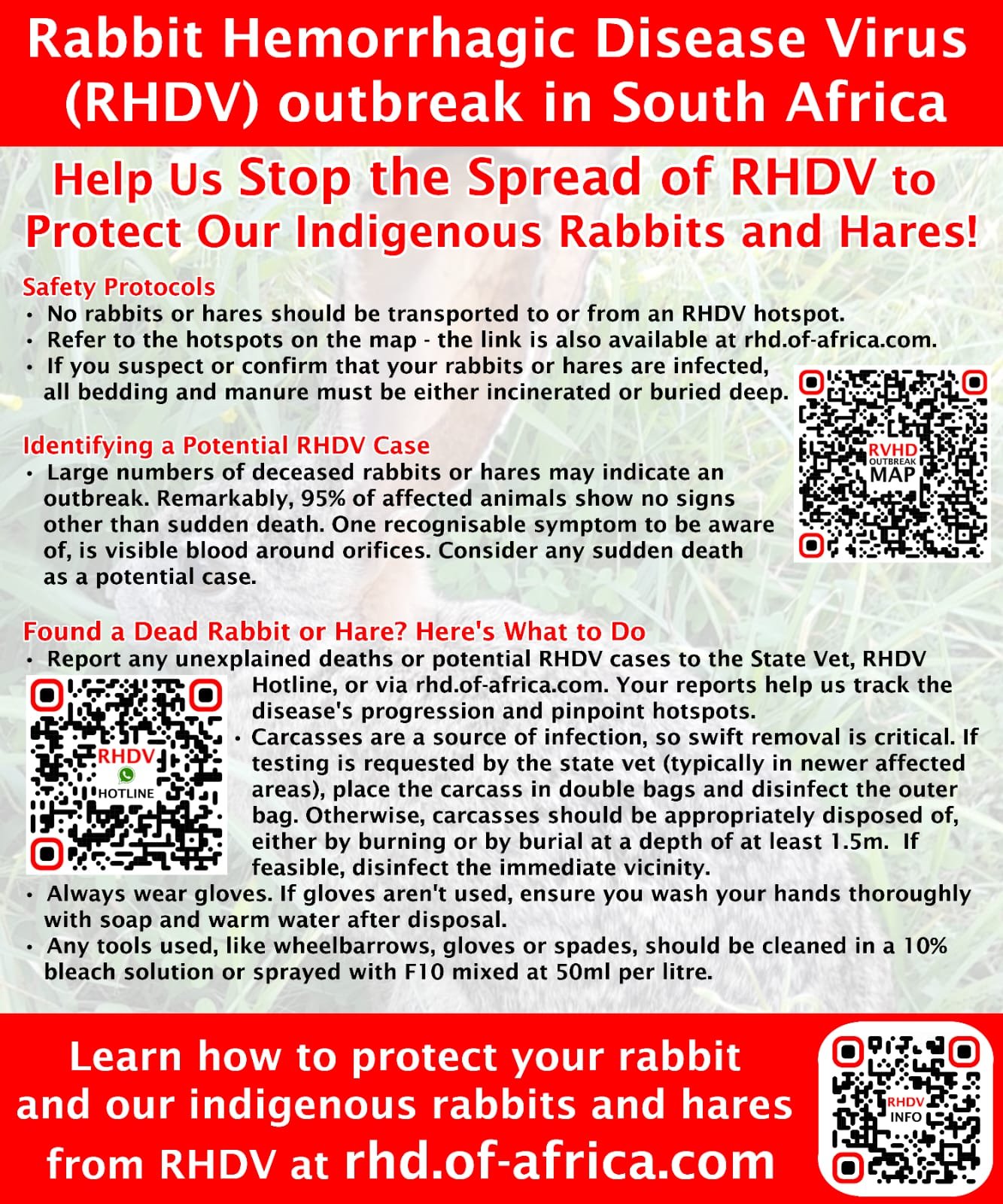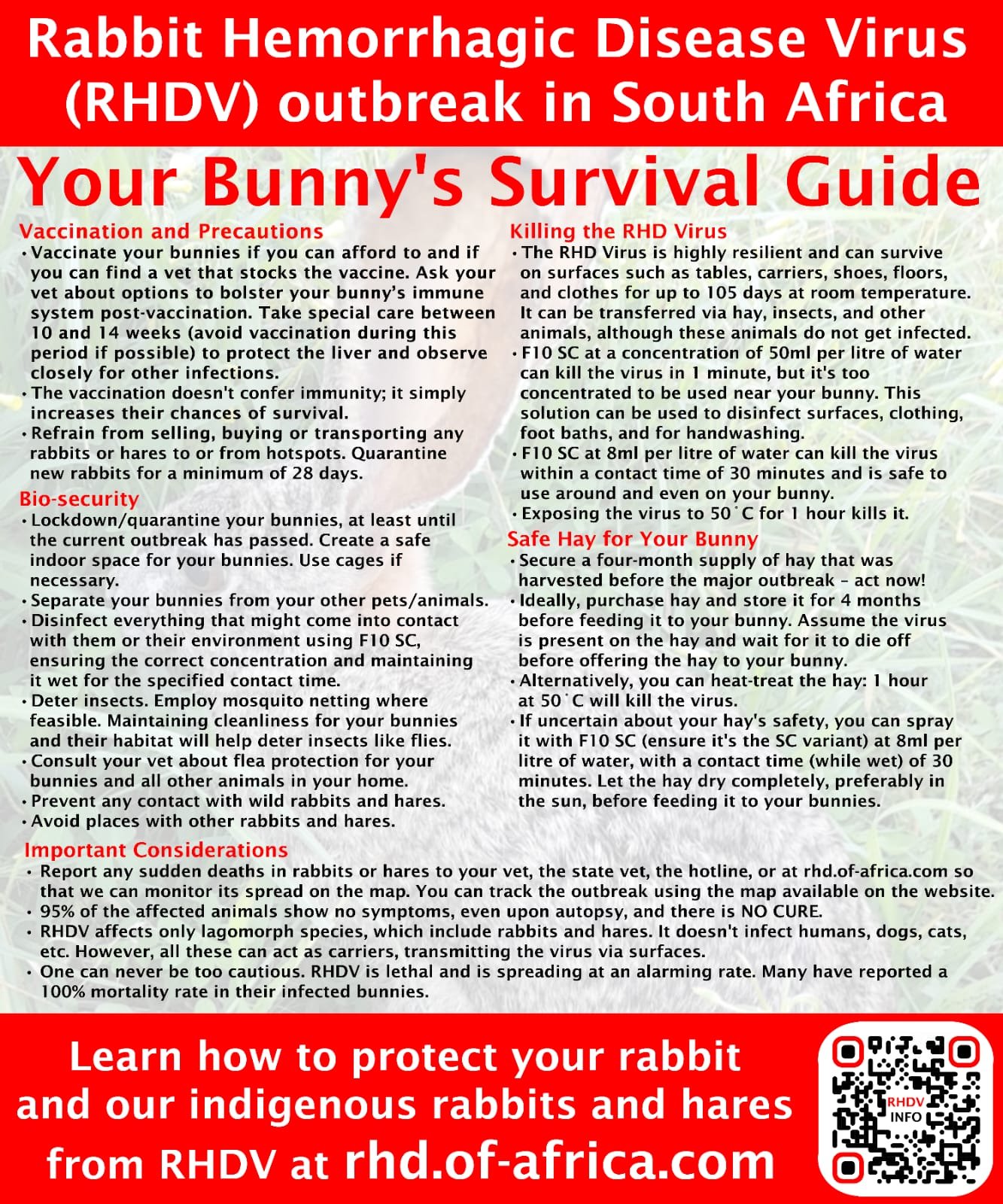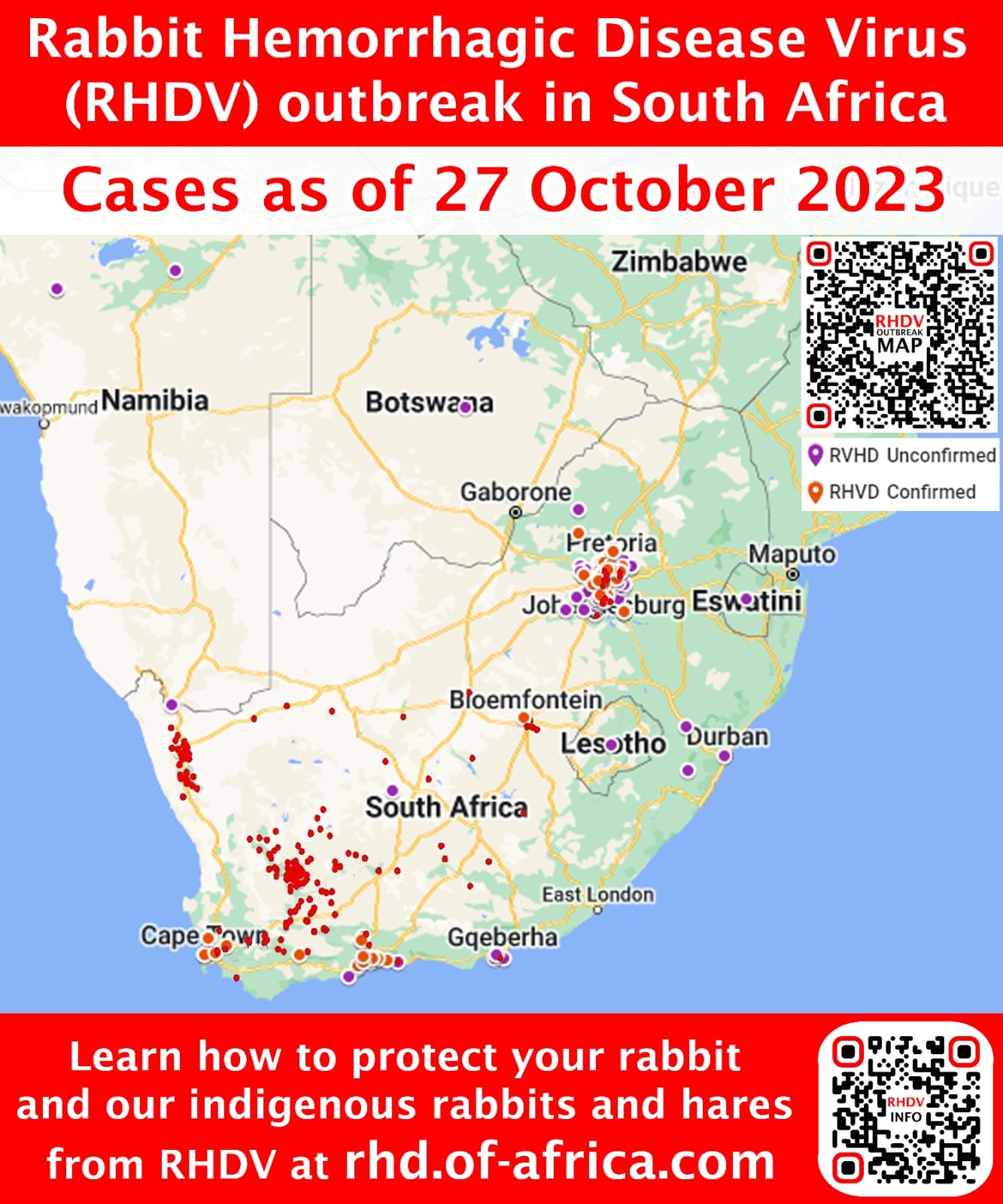If you have an urgent question, please contact one of the RHD-Awareness persons at the bottom of the page in the Footer.
What is RHDV and how does it work?
Rabbit Heamoragic Disease Virus is a virus made specifically for lagomorphs (rabbits and hares) and RHDV2 is the one affecting South Africa.
It affects and infects ONLY lagomorphic species (rabbits, hares and pika).
It is similar to the Ebola Virus and loosely called Bunny Ebola.
It is a highly infectious disease that spreads very easily and is super hardy.
Freezing has basically no effect of the virus, heat of 50° is needed for 30 minutes, most disinfectants is too weak to kill it and it can even be spread by a fly that visited a dead rabbit in the veld, and then move over to your rabbits.
It causes massive heamorage of the internal organs, leading to death.
Can I, my dog, cat or other pet get this?
NO, Rabbit Heamoragic Disease Virus ONLY targets lagomorphic species (Rabbits, Hares and Pika). You or Your other pet however can spread the disease by acting as a carrier if you do not disinfect properly. You, or ANY other animal including your hamster, guinea pig etc, cannot get infected, but can carry the disease on your clothes, in your hair, paws, feathers, etc to where it can reach the next rabbit.
Can a bird of Prey or other predator get sick from eating an infected rabbit?
NO, BUT while they do not get sick themselves, they can carry the virus further even by a hair on their feathers. Also, the meat carry infection and can be passed through their guts, so their poop can carry the infection.
Can my rabbit get RHDV even when vaccinated?
YES! Your rabbit can still get the virus and get very sick, and may need support to survive it. However, while an Unvaccinated rabbit have less than 1 % chance to survive, a vaccinated rabbit has 75% + chance to survive.
What if I do not trust the vaccine?
You need to remember that this virus has been know from 1984 allready when it started in China the first time. It was perfected to kill fast in Australia, and a vaccine was made the same time as the virus. This is not an “on the go” vaccine, it has been used for many years. It has been tested extensively. There are a number of different vaccines available.
Can my rabbit get sick from being Vaccinated?
Yes, some rabbits feel a bit off for the first 24 hrs. They may be quiet, sleep more, show lethargy, eat very little and have a fever. Some has reported to have loose stool for a day after vaccination. Most rabbits show no signs.
Babies aged 8 weeks to 14 weeks may get very sick though. This is because they do not have their mom’s immune cells to make them stronger, they do not yet have their own strong immunity and their livers are not yet mature. They are thus fragile, and can easily get secondary infection.
Can a rabbit that was vaccinated transmit the disease due to vaccination?
No, they cannot. The vaccine is not made from live cells, so your rabbit is not infectious to others.
Your rabbit may however carry the disease if he was in contact with another RHDV rabbit, or if he had contracted RHDV and can be a carrier for up to 60 days.
What vaccine do we use in South Africa and how does it work?
We have been granted a permit on the ERAVAC vaccine. This vaccine is administered in a once-a-year-shot and do bot require a booster in just a few weeks after the first shot. It does need a new shot within 11.5 months to ensure your rabbit is covered for the next year – much like a dog’s rabies shot
Does my rabbit need to be weighed for the vaccination and what will the vet do?
Your vet may do a full consultation including weighing just for the records, but weighing is not vital.
The amount of vaccine is the same for big or small rabbits, as it is different to medicine and the process is targeting a certain number of cells to be triggered and activated in order to make white blood cells. Thus, only this amount of cells /vaccine is administered.
Vets may do the quick consult (feeling if any of the vital organs are swolen etc) in the safety of your vehicle, and they will fully disinfect themselves before and after.
How long does it take for the Vaccine to work?
From 5 to 14 days, depending on the rabbits overall health and age. Most rabbits are protected after 5 days. Vets should not do any operations before 7 days post vaccination.
Who must we be careful to vaccinate?
Any rabbit who has or had in the last 6 months any liver anomaly is especially in danger of getting sick. This includes fatty liver syndrome, liver torsion, any previous disease that effects the liver like tickbite fever, hepatic coccidiosis etc. Rabbits hide the fact that they feel ill very well, so when you see them acting off, they are allready very sick.
How do I prepare my rabbit for vaccination?
Like before any normal vet visit, please feed your rabbit a generous helping of pellets, greens and carrot treats directly before you leave, to ensure the gut is full and working to an optimum. This helps prevent stasis. You may want to give your rabbit milk thistle to help the liver, for a few days prior to vaccination, but stop at least 2 days before to let the liver rest.
How do I support my rabbit that is not feeling well after vaccination?
Make sure your rabbit has a stable temperature in the room (not too cold or hot,) and that he or she does eat something and get in fluids. Keep making sure about fluids, every 2-3 hours at least. * Refer to our Intensive Care guide for more info*
What is the more common symptoms seen after vaccination?
– lethargy
– loss of appitite
– swelling at the injection site
– slight fever
– sore muscles
What are the most common symptoms seen after contracting RHDV2?
Please note in most cases people do not see any signs, and signs can only be present for 1-4 hrs before death. Also note that less than 5% rabbits show any signs of bleeding after they have passed.
Symptoms as they progress – not all rabbits show all these, these are the collective from our data. These are the horrible facts, please try and prepare yourself.
– Loss of balance
– lethargy
– fever
– breathing with abdomen
– wet nose and severe trouble breathing
– sneezing and yawning with bile coming out the mouth or nose,
– death seizure or “swimming” motion as lungs fill with blood and they ‘drown’
– foamy blood from nose, mouth, anus, and eyes.
As said previously, not all rabbits give the same symptoms, and only a fraction of rabbits have any outward signs after death. Thus a necropsy is needed, where the vet will see the bleeding on the inside in the organs.
What is Biosecurity?
Biosecurity is the preventative / protective measures you set in place to protect your rabbits. From disinfecting properly, to footbaths (because “feet” is a huge way to spread this disease) to spraying your rabbits area with certain sprays, to you not going into petstores, visiting other rabbit owners etc, and quarentine your rabbits; to upholding the asked travel and sales ban, to ensuring your rabbits are insect free and have immune boosters, this all fall under biosecurity.
What measures can I take in biosecurity?
– Quarentine your rabbits – no one goes in or out without proper sanitisation.
– Disinfect their cages every day or more even – spray a 50ml/1l mix on cages, floors, etc and leave to dry for at least a minute, where your rabbit is NOT inside or close. (Beware your nose and eyes for burning, as this solution is strong but very effective).
Use 10ml/1l for when your rabbits are in the area, remembering that 15 minutes contact time is needed to kill the virus
– Do disinfectant foot baths: place F10 of 50ml/liter in a litter tray or plastic tub, and stand in there so the soles of your shoes are properly wet, for 1 minute. Then step onto a sptayed moist towel to help dry your soles.
– Ensure that you do not carry from an infected animal any hairs, particles etc in your hair, beard, on your clothes or anywhere else.
-Spray the area with Coloidal Silver or F10 to make sure the virus do not attach anywhere in the area. This goes for walls etc.
– Do not visit any places where other rabbits are kept, like petstores, or shows, or anywhere else like parks etc where rabbits are or roam, as you can get infection from them and carry to your house.
– Disinfect your car inside, and take a spraybottle of F10 with to spray your hands and soles of your shoes before you get into your car.
– Even spray your car tires if you went on a road that have active spread or where you saw dead animals.
-Watch where you get your hay from! Hay can carry the virus for up to 4 months.
Help my rabbit passed away suddenly!
Please put the body in a double or even tripple plastic bag while avoiding to touch the body with bare hands; and take to your closest vet for testing.
– your vet can do a necropsy (animal autopsy) and look for the needed signs, and if unsure of RHD, can send tissue samples in to the state vet for proper diagnosis.
– do not keep the rabbit in your fridge or freezer, try and keep it cool overnight with ice packs (need proper disinfection afterwards) and to the vets first thing in the morning if it happened in the night. It is really important to try and get a positive or negative diagnosis. If kept in tour fridge, it can spread to your food, and while this do nothing to you yourself, it can be spread in many ways from there even when preparing the food to eat. We need to contain the spread.
If you cannot do this, and have to dispose, NEVER use the trash. Burrial MUST be deeper than 1.5m and using agricultural limestone to contain the virus. Burning or inceneration is good.
Please burn /burry ALL the rabbits litter of the past few days, blankets and toys should rather be burned, and all washable surfaces including wire, litterboxes etc musy be washed with strong f10 solution.
Always fill out a report to us on the website of where, when, how many and other info of when your rabbit passed, as well as if it was confirmed by a vet to be RHD. This is needed for documentation of the disease.
How do I support my vaccinated rabbit with active RHD?
Remember, while there is no cure, you have to support your rabbit in the same way as when they have another illness, like stasis. You need to ensure they get fluids, feeding if they do not eat themselves, monitor poop and wee, maintain temperature.
Make sure your rabbit stays upright lying in the “loaf” position and not on the side.
* Refer to our Intensive Care guide for more info*




*coming in a fortnight – if you need urgent help, contact Monique: 060 466 2810
